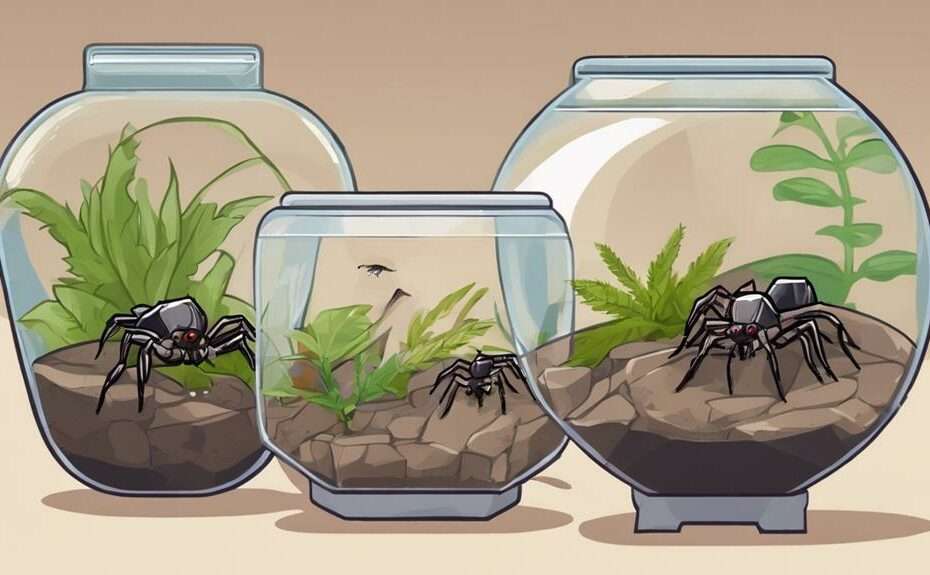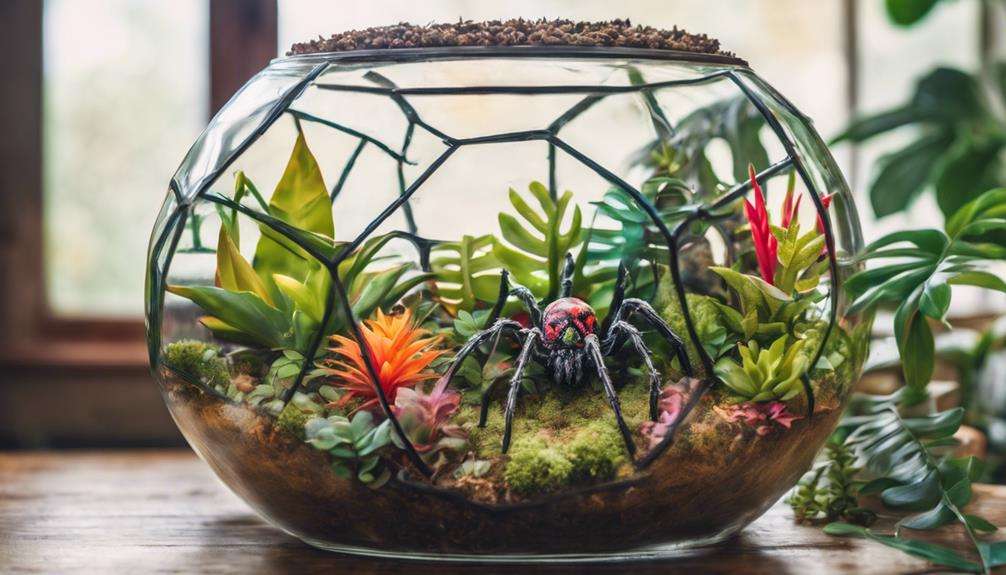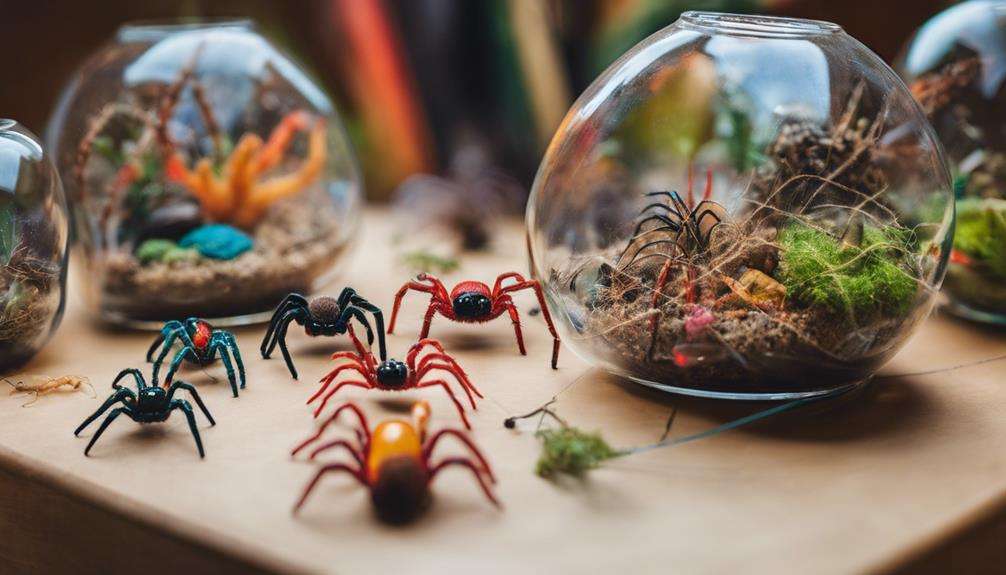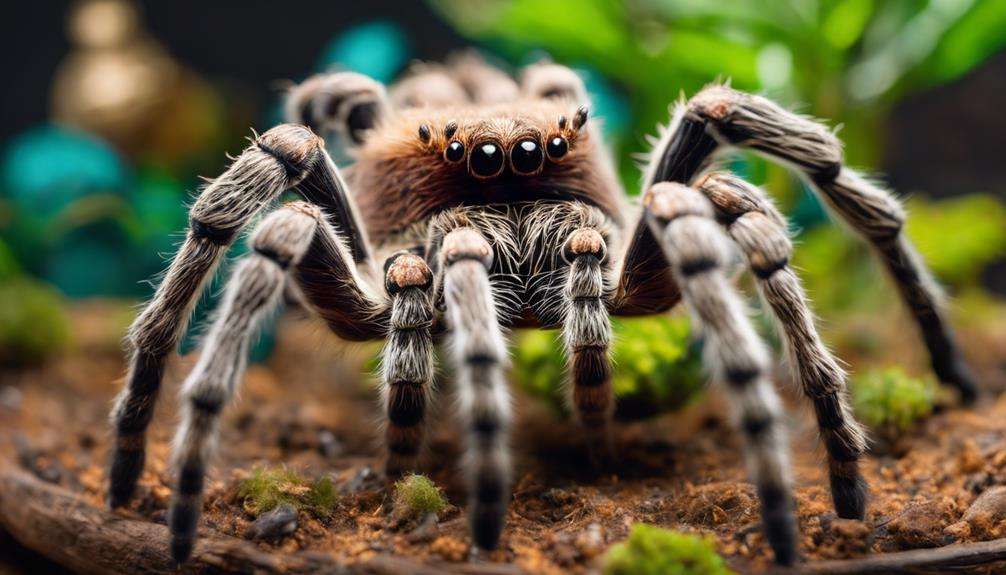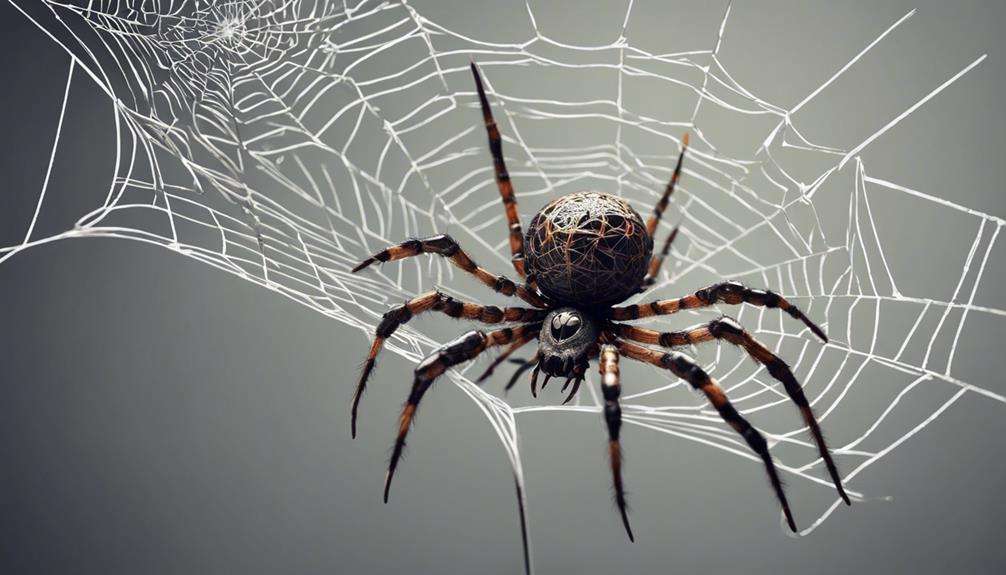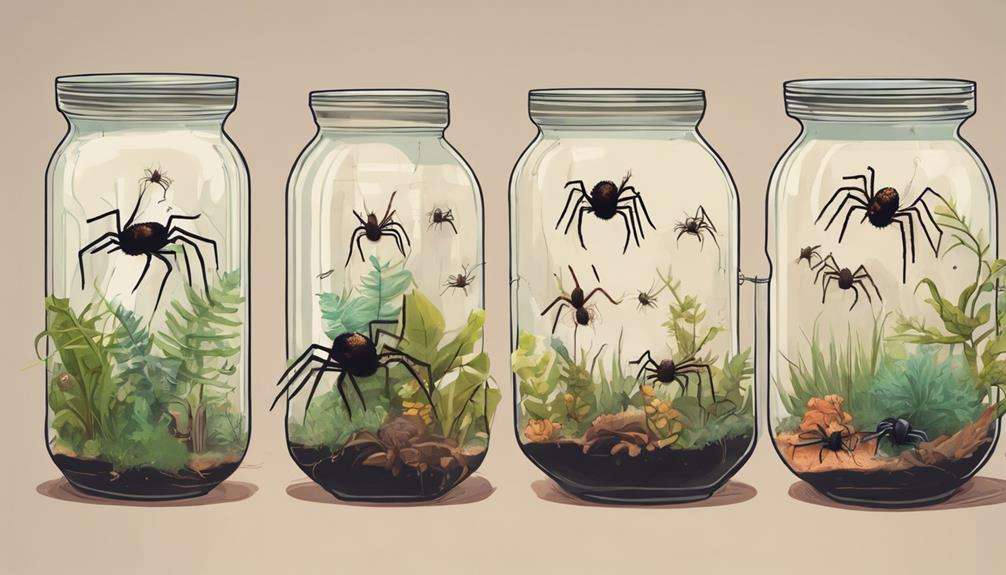Looking to explore a unique and intriguing pet option? Low-maintenance spider pets provide a fascinating entry point into the world of arachnids.
As a beginner, you might be surprised by the simplicity and interest these creatures can bring into your life. But what exactly makes them so appealing to new spider enthusiasts?
Let's uncover the reasons behind their growing popularity and why they might be the perfect choice for your next pet venture.
Key Takeaways
- Tarantulas like Curlyhair and Pink-Toed are ideal for beginners due to their low-maintenance nature.
- Orb Weavers and Black Widows are easy to care for and require minimal feeding.
- Huntsman and Crab Spiders need climbing opportunities and hiding spaces in their tanks.
- Green Lynx Spiders are perfect for beginners, offering natural pest control and mesmerizing colors.
Orb Weaver
Orb Weavers fascinate enthusiasts with their nocturnal hunting habits, making them an intriguing choice for those seeking a low-maintenance spider pet. Despite being rare in pet stores, these creatures are interesting to observe. Found commonly in gardens, fields, and forests, Orb Weavers require a spacious enclosure, ideally a 45-gallon tank, to thrive. This ample space allows them to exhibit their natural web-spinning behavior, a spectacle in itself.
Their activity during the evening adds to their allure, as they diligently work to catch nocturnal insects. Due to their peaceful nature and easy care requirements, Orb Weavers are well-suited for beginners looking to venture into the world of spider keeping. Providing them with a suitable environment to spin their intricate webs not only enhances their well-being but also offers enthusiasts a chance to witness their fascinating behaviors up close.
In essence, Orb Weavers stand out as an excellent option for those intrigued by arachnids and seeking a rewarding yet low-maintenance pet experience.
Black Widow
Known for their venomous nature and distinctive black bodies with red hourglass markings, Black Widows are intriguing low-maintenance spider pets that require minimal care and attention. These spiders are active hunters, which means they don't need to be fed as frequently as other pets and can go weeks without eating.
Black Widows are relatively inexpensive to keep, needing only a 5-gallon tank to thrive. However, it's essential to note that they aren't suitable for handling due to their venomous bite. Their distinctive markings make them easy to identify, adding to their allure as unique pets.
If you're looking for a fascinating spider companion that's easy to care for and observe, the Black Widow could be an excellent choice for you. Just remember to admire them from a safe distance and enjoy their beauty and hunting skills without the need for direct interaction.
Huntsman Spider
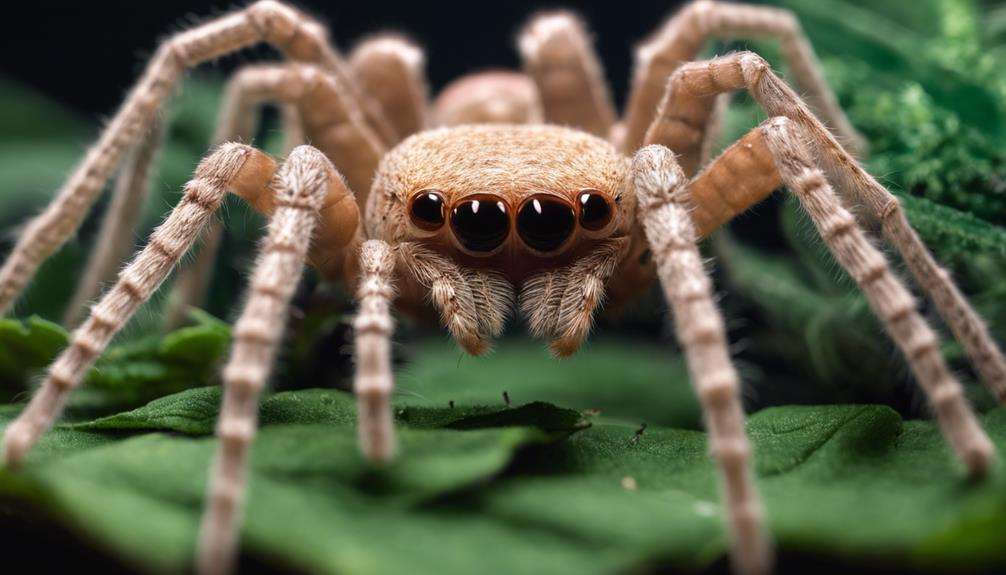
Huntsman spiders, with their strikingly large size and diverse color variations, are intriguing low-maintenance spider pets suitable for beginners due to their mostly non-venomous and carnivorous nature. These arachnids are nocturnal creatures that seek hiding places during the day, making them well-suited for living in narrow spaces within a tank setup.
Known for their impressive size and long legs, ranging in colors from grey to brown, Huntsman spiders offer a visually mesmerizing addition to your home. While some species can display aggressive behavior, there are docile Huntsman spider options available for those looking for a more laid-back pet.
These spiders prefer resting on vertical surfaces, so providing ample climbing opportunities in their enclosure is essential for their well-being. Additionally, incorporating hiding spaces will offer them comfort and security, allowing them to exhibit their natural behaviors in a captive setting.
Costa Rican Zebra Tarantula
The Costa Rican Zebra Tarantula, a hardy pet choice for beginners, boasts a striking appearance with its white knee stripes.
To guarantee its well-being, it's vital to maintain specific temperature and humidity levels in its 10-gallon tank habitat.
While this tarantula is low-maintenance, handling should be limited due to its shy nature.
Feeding Habits
To guarantee the prime health and well-being of your Costa Rican Zebra Tarantula, it's important to provide a diet consisting of live insect prey to meet their carnivorous feeding habits. These tarantulas require a diet that aligns with their natural predatory instincts.
Feeding your Costa Rican Zebra Tarantula a variety of live prey items is essential to make sure they receive the necessary nutrients and stay healthy and active. By offering live insects as part of their diet, you're supporting their nutritional needs and promoting their overall well-being.
Understanding and adhering to the proper feeding habits for your Costa Rican Zebra Tarantula will help keep them vibrant and thriving in their habitat.
Ideal Habitat Setup
When setting up the ideal habitat for your Costa Rican Zebra Tarantula, make sure that the 10-gallon tank maintains specific temperature and humidity levels suited to this species. This hardy pet, perfect for beginners, thrives in environments with temperatures around 75-85°F (24-29°C) and humidity levels between 70-80%.
The unique appearance of white knee stripes makes the Costa Rican Zebra Tarantula a visually striking addition to your home. Guarantee the tank has ample substrate for burrowing, a hiding place, and a shallow water dish.
Regularly monitor and adjust the temperature and humidity levels to mimic its natural habitat. With its low-maintenance nature and specific habitat requirements, your Costa Rican Zebra Tarantula will flourish in a well-prepared tank.
Handling Tips
For safely interacting with your Costa Rican Zebra Tarantula, consider utilizing specialized handling tools to minimize stress for your pet. Due to their shy nature, Costa Rican Zebra Tarantulas are unlikely to enjoy being handled and may become agitated if forced to do so.
It's important to maintain specific temperature and humidity levels within their enclosure to guarantee their well-being. These hardy pets are a low-maintenance choice for beginners, but their unique appearance with white knee stripes requires careful observation rather than handling.
Providing a spacious 10-gallon tank will give your tarantula ample room to move around and explore. Remember to prioritize the comfort and health of your Costa Rican Zebra Tarantula by creating a suitable environment for them to thrive in.
Fishing Spider
Fishing spiders showcase a unique hunting behavior by using the surface tension of water to catch prey, making them fascinating to observe in their aquatic habitat. Their preference for living near water sources and ability to glide on water make them stand out from other spider species.
Despite their intimidating appearance, fishing spiders aren't aggressive towards humans, making them a low-maintenance and intriguing pet option for enthusiasts.
Unique Hunting Behavior
With their unique ability to dive, swim, and glide on water surfaces, fishing spiders exhibit an enchanting hunting behavior that sets them apart from other spider species. These water spiders, ideal for observation in a 10-gallon tank, display defensive behavior when threatened, advising against handling.
To simulate their natural habitat, provide a tank with live plants and water sources for hunting opportunities. Fishing spiders' enthralling hunting behavior unfolds in their aquatic environment, making them an exciting choice for spider enthusiasts. Watching them actively pursue prey showcases their agility and adaptability to underwater environments.
This distinctive trait adds an element of intrigue to caring for these fascinating arachnids, offering a unique glimpse into the hunting strategies of aquatic spiders.
Aquatic Habitat Preference
In their natural habitat, fishing spiders demonstrate a clear preference for aquatic environments, showcasing their remarkable ability to navigate and thrive in water settings. These water spiders are adept at diving, swimming, and even gliding on the water's surface.
While they've a defensive nature and appear intimidating due to their size, fishing spiders are surprisingly easy to care for. Providing them with a 10-gallon tank with live plants and access to water is essential for their well-being.
Due to their defensive instincts, it's important to avoid handling fishing spiders. Understanding and respecting their need for an aquatic habitat is critical for creating a suitable environment for these fascinating arachnids.
Not Aggressive Towards Humans
Despite their intimidating size and appearance, water spiders, also known as fishing spiders, exhibit a non-aggressive behavior towards humans. These fascinating creatures are easy to care for as pets and possess unique abilities such as diving, swimming, and gliding on water surfaces.
To provide a suitable habitat for fishing spiders, a 10-gallon tank with live plants and access to water is essential. While they're quick to defend themselves when feeling threatened, fishing spiders aren't recommended for handling due to their defensive nature.
Observing their natural behaviors like diving and swimming can be a rewarding experience without the need for direct interaction, making them an intriguing addition to your low-maintenance pet collection.
Green Lynx
A notable feature of the Green Lynx spider is its easily identifiable green body and clear-yellow legs. These spiders are aggressive insect predators, relying on their speed and agility to catch prey rather than spinning webs. Due to their small size, Green Lynx spiders are perfect for beginners seeking a low-maintenance pet option. Housing them in a 5-gallon tank is sufficient, as they don't have specific heat or humidity requirements, making care relatively straightforward.
One of the benefits of having a Green Lynx spider as a pet is its natural pest control abilities. Their hunting behavior makes them excellent at keeping insect populations in check, making them particularly useful in gardens. Observing their vibrant green bodies and clear-yellow legs as they move around can be quite mesmerizing. Overall, the Green Lynx spider is a great choice for those looking to enjoy the presence of a mesmerizing arachnid while also benefiting from its practical pest control instincts.
Curlyhair Tarantula
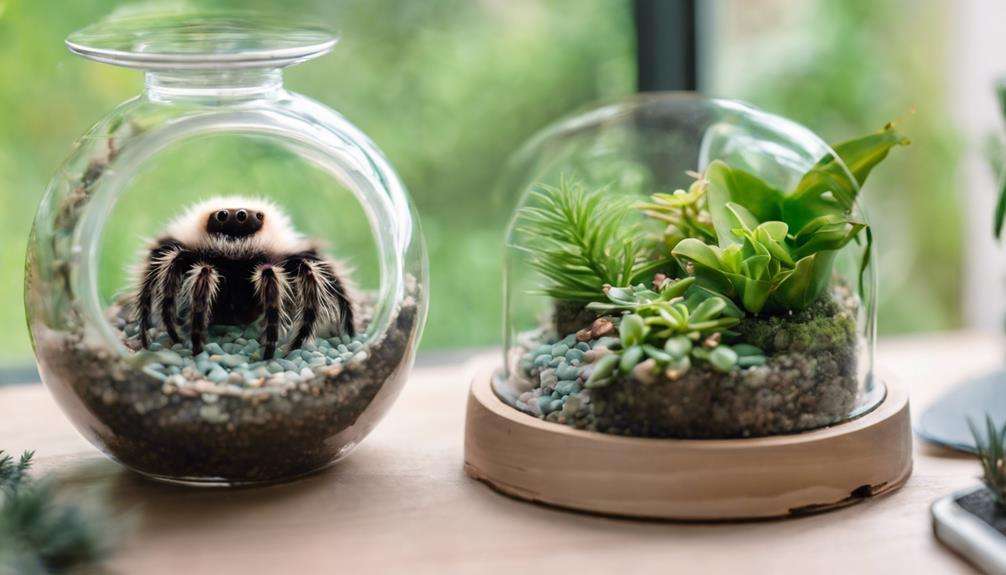
The Curlyhair Tarantula, known for its woolly appearance and calm demeanor, is a popular choice for beginners as they rarely encounter health issues. These low-maintenance creatures are ideal for novice pet owners. Their healthy nature and low space requirements make them excellent beginner pets.
Curlyhair Tarantulas are often found in pet stores due to their attractive woolly appearance, drawing in many enthusiasts. In their tanks, they're mostly motionless, adding to their ease of care. However, thus note that while generally docile, they may bite if startled, so handling should be minimal.
Tank sizes for Curlyhair Tarantulas can vary based on individual needs, but a basic setup with substrate for burrowing and a water dish is typically sufficient. With the right environment and minimal interaction, these tarantulas can thrive and bring joy to beginner arachnid enthusiasts.
Crab Spider
Crab spiders, belonging to the Thomisidae family and boasting a unique crab-like appearance, are fascinating creatures that captivate enthusiasts with their hunting prowess and natural charm. These spiders, with thousands of species worldwide, are easy to care for, making them an excellent choice for beginners.
To make their well-being in captivity, it's essential to mimic their natural environment. Crab spiders don't spin webs; instead, they rely on camouflage to efficiently hunt their prey. Providing ample hiding spots in their habitat is important for these spiders to feel secure. Their unique appearance, resembling crabs in both physical features and hunting behavior, adds to their allure.
Creating a suitable environment that mirrors their natural habitat will help these spiders thrive. By understanding their needs and behaviors, you can enjoy observing the captivating nature of crab spiders in a low-maintenance setting.
Pink-Toed Tarantula
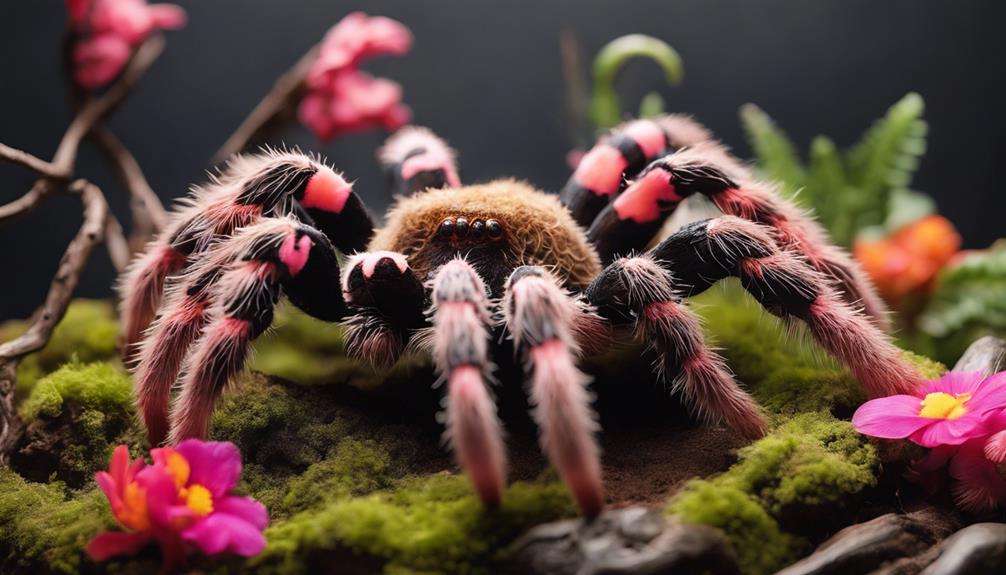
Native to South America and known for their distinctive orange-pink-tipped feet, Pink-Toed Tarantulas are tree-dwelling spiders prized for their docile nature, making them an ideal choice for novice spider enthusiasts. These friendly spiders have a reputation for being great for beginners due to their calm demeanor.
To cater to their arboreal nature, Pink-Toed Tarantulas require a tall tank with plenty of climbing spaces to explore. These spiders can even live together with others of the same species, allowing for a social living arrangement if desired. Ensuring a suitable environment with adequate climbing opportunities is essential for the well-being of Pink-Toed Tarantulas.
Providing a mix of vertical surfaces and branches will help mimic their natural habitat and keep them happy and healthy. If you're looking for a low-maintenance pet that offers a unique and rewarding experience, consider welcoming a Pink-Toed Tarantula into your home.
Frequently Asked Questions
What Is the Easiest Spider to Keep as a Pet?
The Chilean Rose Tarantula ranks as one of the easiest spiders to keep as a pet due to its docile demeanor and simple care requirements. Their friendly nature and longevity make them an ideal choice for beginners.
What Spider Is Best for Beginners?
When considering spider species for beginners, focus on ease of handling, suitable habitats, feeding habits, behavior, health, enrichment, accessories, misconceptions, and bonding opportunities. Choosing the right spider will enhance your pet-keeping experience.
What Is the Most Friendliest Spider?
When looking for the friendliest spider, consider the Pink Toe Tarantula. Their calm demeanor and ease of handling make them ideal for beginners. With proper tarantula care, they can live up to 10-12 years in captivity.
Are Pet Spiders Hard to Take Care Of?
Taking care of pet spiders can be manageable with proper attention to spider feeding, enclosure setup, handling tips, molting process, behavior, health concerns, habitat enrichment, spider species, temperature regulation, and a consistent cleaning routine.
Conclusion
Thus, when considering low-maintenance spider pets for beginners, the Curlyhair Tarantula, Green Lynx, and Pink-Toed Tarantula stand out as excellent choices.
These fascinating arachnids offer a unique and rewarding experience with their docile nature and straightforward care requirements.
So, whether you're a novice spider owner or an experienced enthusiast, adding one of these spiders to your collection is sure to provide hours of enjoyment and an anachronism of excitement.
